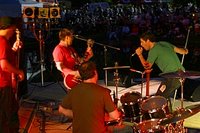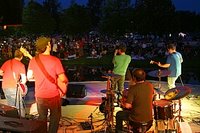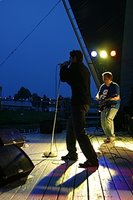A pre-cursor to Paint Ball? - Lee Hawkers – a 1960s Cape Breton Teenager Hide-'n-Seek Game

There are segments of sociology, found perhaps only on Cape Breton Island, that need to be recorded, if not studied. The game of “Lee Hawkers” is such a segment; a common summer night cry of “1-2-3 Lee Hawkers” heard from the woods surrounding the New Waterford neighbourhood of Cape Breton Island, Nova Scotia. This game of modified hide-and-seek involving two teams was part of teen years in the mid-1960s. Lee Hawkers was a creative hide-and-seek game played in the specific suburban area of New Waterford called River Ryan/Scotchtown.
The River Ryan/Scotchtown area was, and still is today, a residential community. Unlike today back then the neighbourhoods were more widely interlaced with forests and fields. Throughout the 1960s, summer days would see teenaged boys playing baseball, pitching horseshoes, building forts in the woods, shooting practice rounds with BB guns , or biking out of town to Kilkenny Lake for a swim. But what would these typically testosterone-driven males do for night-time fun? What mischief could they find cloaked in the darkness of sultry summer nights?
The mischief arose when the child's game of Hide-and-Seek morphed into a more adult oriented game involving two teams, a 'jail' and few, but specific, rules of engagement around being captured and being freed from jail.
The best recollection is that this after dark game was originally a male only sport. Two teams of male teens would take turns being the captured (Hiders) or the captors (Seekers). To begin, in a clearing, a field or in someone's dirt driveway, using a tree branch or the heel of a player's boot or sneaker, a large circle (6-8 feet in diameter) would be roughly marked in the sun-baked ground. This would become the jail into which the captured Hiders would be thrown by the Seekers.
To capture or catch a hiding member of the opposing team, the Seekers would start their hunt in the dark wooded areas for any Hiders. It's dark. It's the forest. Seekers could jump out at a Hider... so usually the hunt was carried out in pairs of Seekers. But why the name Lee Hawkers? Read on... once a Hider was isolated, according to the original rules of seek and capture, a Seeker would be required to spit (yes a hawker!) on the Hider, pound them on the back while yelling “1-2-3 Lee Hawkers”. This marked the Hider as a “catch” or “captured”. The Seekers would lead the captured Hider back to jail (the circle) for safe keeping. The “Lee” (short for leeward) in “Lee Hawkers” was a obvious warning that you should spit, or hawk, in the direction of the wind to avoid getting hit with your own spit (ugh!). And so this spitting, or hawking - the “1-2-3 Lee Hawkers” capture sequence - would be repeated until all the Hiders were caught and in jail. Once all the Hiders were captured, the teams would switch roles – Seekers would become Hiders and Hiders would become Seekers. Hide. Catch. Jail. Switch. Were that the game was so simplistic. The game was a more complicated and a whole lot more dynamic because jailed Hiders could be freed from “jail”. Say what!
The jail was guarded by a couple Seekers. These Guard Seekers remained on high alert to prevent Hider teammates from freeing their jailed buddies. If an uncaptured Hider ran through the jail then all jailed Hiders were now technically freed from jail, free to run back into the forest and hide once again. How could the Seekers stop these repeated breakouts?
The trick was to catch these rogue Hider breakout experts before they ran through the jail. By using the same capture 1-2-3 sequence (hawking, back pounding, yelling ”1-2-3 Lee Hawkers”) it would not only stop a breakout attempt but also result in a fresh Hider capture. “Off to jail with ya!” At this point in the evolution of Lee Hawkers you have a teen male-dominated, hawkin' 'n hittin', after dark, hide 'n seek game. A bit messy, somewhat primitive, but relatively harmless.
Enter the teen girls. They want to play. Co-ed Lee Hawkers. This had new possibilities, new promise. Hmmm, a thought. A thought that met an age-old goal – have some fun while you find a mate.Just like the Stag Line (see Wikipedia or My BLOG), Lee Hawkers seems to have evolved from an excuse for a dating game wrapped in the guise of team sports.Or was Lee Hawkers a primative form of the game now called Paint Ball? Could Paint Ball splats of color have replaced the spit, or hawker, in the culturally historical Cape Breton game of Lee Hawkers? Or was this game called Lee Hawkers simply a ruse by teenage boys to play with the girls? Surely these are questions requiring further discussion.
The girls were in the game. But first the spitin' and hawkin' had to go! And so it did. Lee Hawkers became a more gentile sport for the combined sexes. Catching a Hider now involved only “rapping” (lightly pounding) a girl Hider on the back while yelling “1-2-3 Lee Hawkers”. Since the new rules eliminated hawking, Hiders about to be captured, would no longer run to avoid the 'guber'. Instead Hiders would resist capture by the Seeker by lying on their back to prevent from being rapped. Based on the size/strength ratio of Seeker-to-Hider, the attempt(s) to flip and “back rap” could turn out to be quite an extended tussle. Sometimes it would require the efforts of 2 or more Seekers to flip and rap a potential captured Hider.
Now let your imaginations fill in the blanks here. Imagine what happened when the Hider was a female, the Seeker was a male. Hider – female. Seeker – male. Tussle. If the Seeker was a male, and he discovered a female Hider, he would never call for help from his Seeker teammates. This is the part where subtle changes in the 'unwritten' rules came into effect when the girls joined the game. The effort was always different in these female-to-male capture encounters. There was an unspoken adjustment in the game rules and a somewhat neutralizing of male brute force. The male Seeker would tussle gently with the female Hider until she could be flipped or rolled off her back, and the male Seeker's was able to tap her back combined with the cry “1-2-3 Lee Hawkers”. It was amazing the length of time it took for one strong teen male to perform a simple 45 to 90 degree roll of a female to gain access to her back. It must that unexplainable physics of females!
Like the game of Lee Hawkers so goes dating, and so goes love. The brute strength in hormone-driven games is neutralized. It becomes gentler. It emotes the chemistry of sexual attraction. And so goes life.
Lee Hawkers was one of those 1960s Cape Breton (or at least a Scotchtown – River Ryan) phenomena that, perhaps just like the Stag Line, was a dating game ritual wrapped in the guise of team sports. Or maybe it was the pre-cursor to today's Paint Ball. Whatever it was, it sure was memorable!
Labels: anthropology, cape breton, nova scotia
A pre-cursor to Paint Ball? - Lee Hawkers – a 1960s Cape Breton Teenager Hide-'n-Seek Game






